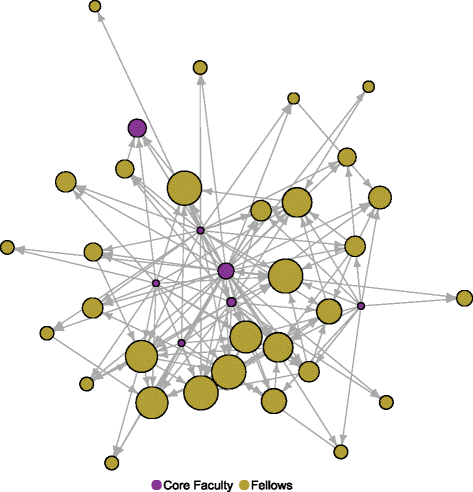Forging a link between mentoring and collaboration: a new training model for implementation science
- PMID: 27737693
- PMCID: PMC5062835
- DOI: 10.1186/s13012-016-0499-y
Forging a link between mentoring and collaboration: a new training model for implementation science
Abstract
Background: Training investigators for the rapidly developing field of implementation science requires both mentoring and scientific collaboration. Using social network descriptive analyses, visualization, and modeling, this paper presents results of an evaluation of the mentoring and collaborations fostered over time through the National Institute of Mental Health (NIMH) supported by Implementation Research Institute (IRI).
Methods: Data were comprised of IRI participant self-reported collaborations and mentoring relationships, measured in three annual surveys from 2012 to 2014. Network descriptive statistics, visualizations, and network statistical modeling were conducted to examine patterns of mentoring and collaboration among IRI participants and to model the relationship between mentoring and subsequent collaboration.
Results: Findings suggest that IRI is successful in forming mentoring relationships among its participants, and that these mentoring relationships are related to future scientific collaborations. Exponential random graph network models demonstrated that mentoring received in 2012 was positively and significantly related to the likelihood of having a scientific collaboration 2 years later in 2014 (p = 0.001). More specifically, mentoring was significantly related to future collaborations focusing on new research (p = 0.009), grant submissions (p = 0.003), and publications (p = 0.017). Predictions based on the network model suggest that for every additional mentoring relationships established in 2012, the likelihood of a scientific collaboration 2 years later is increased by almost 7 %.
Conclusions: These results support the importance of mentoring in implementation science specifically and team science more generally. Mentoring relationships were established quickly and early by the IRI core faculty. IRI fellows reported increasing scientific collaboration of all types over time, including starting new research, submitting new grants, presenting research results, and publishing peer-reviewed papers. Statistical network models demonstrated that mentoring was strongly and significantly related to subsequent scientific collaboration, which supported a core design principle of the IRI. Future work should establish the link between mentoring and scientific productivity. These results may be of interest to team science, as they suggest the importance of mentoring for future team collaborations, as well as illustrate the utility of network analysis for studying team characteristics and activities.
Keywords: Implementation Research Institute; Implementation science; Mentoring; Network analysis; Scientific collaboration; Team science; Training.
Figures





References
-
- U.S. Department of Health and Human Services. Mental Health: A Report of the Surgeon General. Rockville; 1999.
-
- Committee on Quality of Health Care in America Institute of Medicine . Crossing the quality chasm: a new health system for the 21st century. Washington, DC: National Academy Press; 2001.
-
- Colditz GA. The promise and challenges of dissemination and implementation research. In: Brownson RC, Colditz GA, Proctor EK, editors. Dissemination and implementation research in health: translating science to practice. New York: Oxford University Press; 2012. pp. 3–22.
-
- Dissemination and implementation research in health, PAR-16-238 [http://grants.nih.gov/grants/guide/pa-files/PAR-16-238.html]. Accessed 5 Oct 2016.
-
- National Institute of Mental Health . Investing in the future: national advisory mental health council workgroup on research training. 2008.
MeSH terms
Grants and funding
LinkOut - more resources
Full Text Sources
Other Literature Sources

